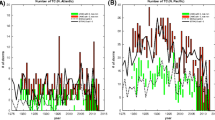Abstract
The present paper develops a methodology for estimating the risks and consequences of possible future increases in tropical cyclone intensities that would allow policy makers to relatively quickly evaluate the cost of different mitigation strategies. The methodology simulates future tropical cyclones by modifying the intensity of historical tropical cyclones between the years 1978 and 2007. It then uses a Monte Carlo Simulation to obtain the expected number of hours that a certain area can expect to be affected by winds of a given strength. The methodology outlined has a range of applications, and the present paper shows as an example the calculation of the expected cost of mitigation of the increased downtime for Japanese ports by 2085 for a variety of economic growth scenarios.
Similar content being viewed by others
References
Bromirski PD, Flick RE et al (2003) Storminess variability along the California coast: 1858–2000. J Climate 16:982–993
Buhaug H, Rød JK (2006) Local determinants of African civil wars, 1970–2001. Polit Geogr 25(2):315–335
Dilley M, Chen RS et al (2005) Natural disaster hotspots: a global risk analysis. International Bank for Reconstruction and Development/The World Bank and Columbia University, Washington D.C.
Elsner JB, Kossin JP, Jagger TH (2008) The increasing intensity of the strongest tropical cyclones. Nature 455:92–94
Giorgi F et al (2001) Regional climate information-evaluation and projections. In: Houghton JT et al (eds) Climate change 2001: the scientific basis, pp 583–638
Japan Meteorological Agency (2008). www.jma.go.jp. Retrieved 1 April 2008
Kawakami T, Doi M (2004) Port capital formation and economic development in Japan: a vector autoregression approach. Pap Reg Sci 83:723–732
Knutson TR, Tuleya RE (2004) Impact of CO2 –induced warming on simulated hurricane intensity and precipitation sensitivity to the choice of climate model and convective parameterization. J Climate 17(18):3477–3495
Knutson TR, Tuleya RE et al (2001) Impact of CO2-induced warming on hurricane intensities as simulated in a hurricane model with ocean coupling. J Climate 14:2458–2468
Landsea CW, Harper BA et al (2006) Can we detect trends in extreme tropical cyclones? Science 313(5786):452–454
Munich Re (2007) Topics geo: natural catastrophes 2006. Munich Re Group, Munich
Munich Re (2009) Natural disasters 1980–2008, 10 costliest typhoons ordered by insured losses. http://www.munichre.com/. Retrieved 28th April 2009
Nordhaus WD (2006) The economics of hurricanes in the United States. Annual Meetings of the American Economic Association, Boston
Port of Dover (2008) http://www.doverport.co.uk/?page=OperatingLimitations-702. Retrieved 23 April 2008
Raleigh C, Jordan L et al (2008) Assessing the impact of climate change on migration and conflict. Paper presented to the World Bank workshop on social dimensions of climate change, The World Bank, Washington D.C., 5–6 March 2008
Stern N (2006) Stern review on the economics of climate change. HM Treasury, London
The Port of Chiba (2008) http://www.pref.chiba.lg.jp/business/kowan/chibaport-e.html. Retrieved 21 April 2008
Thoresen CA (2003) Port designer’s handbook: recommendations and guidelines. Thomas Telford, London
Webster PJ, Holland GJ et al (2005) Changes in tropical cyclone number, duration, and intensity in a warming environment. Science 309(5742):1844–1846
World Meteorological Organisation (2006) 6th International workshop on tropical cyclones. World Meteorological Organisation, San Jose
Author information
Authors and Affiliations
Corresponding author
Rights and permissions
About this article
Cite this article
Esteban, M., Webersik, C. & Shibayama, T. Methodology for the estimation of the increase in time loss due to future increase in tropical cyclone intensity in Japan. Climatic Change 102, 555–578 (2010). https://doi.org/10.1007/s10584-009-9725-9
Received:
Accepted:
Published:
Issue Date:
DOI: https://doi.org/10.1007/s10584-009-9725-9




